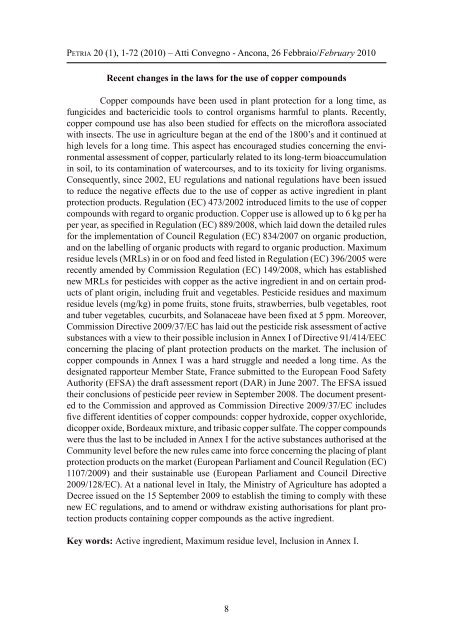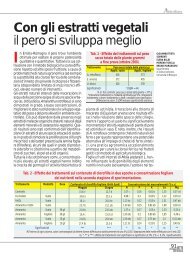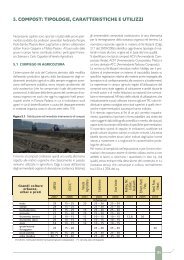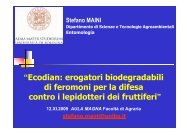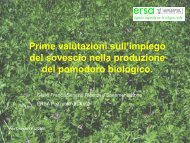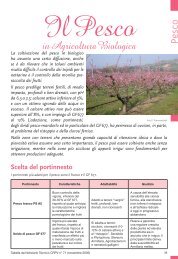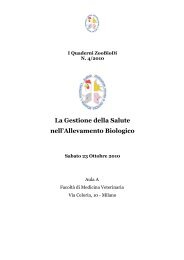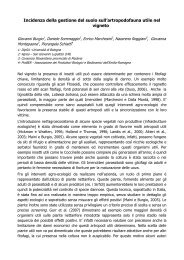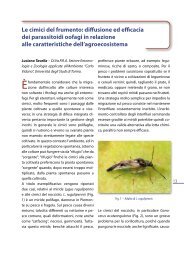You also want an ePaper? Increase the reach of your titles
YUMPU automatically turns print PDFs into web optimized ePapers that Google loves.
Petria 20 (1), 1-72 (2010) – Atti Convegno - Ancona, 26 Febbraio/February 2010Recent changes in the laws for the use of copper compoundsCopper compounds have been used in plant protection for a long time, asfungicides and bactericidic tools to control organisms harmful to plants. Recently,copper compound use has also been studied for effects on the microflora associatedwith insects. The use in agriculture began at the end of the 1800’s and it continued athigh levels for a long time. This aspect has encouraged studies concerning the environmentalassessment of copper, particularly related to its long-term bioaccumulationin soil, to its contamination of watercourses, and to its toxicity for living organisms.Consequently, since 2002, EU regulations and national regulations have been <strong>issue</strong>dto reduce the negative effects due to the use of copper as active ingredient in plantprotection products. Regulation (EC) 473/2002 introduced limits to the use of coppercompounds with regard to organic production. Copper use is allowed up to 6 kg per haper year, as specified in Regulation (EC) 889/2008, which laid down the detailed rulesfor the implementation of Council Regulation (EC) 834/2007 on organic production,and on the labelling of organic products with regard to organic production. Maximumresidue levels (MRLs) in or on food and feed listed in Regulation (EC) 396/2005 wererecently amended by Commission Regulation (EC) 149/2008, which has establishednew MRLs for pesticides with copper as the active ingredient in and on certain productsof plant origin, including fruit and vegetables. Pesticide residues and maximumresidue levels (mg/kg) in pome fruits, stone fruits, strawberries, bulb vegetables, rootand tuber vegetables, cucurbits, and Solanaceae have been fixed at 5 ppm. Moreover,Commission Directive 2009/37/EC has laid out the pesticide risk assessment of activesubstances with a view to their possible inclusion in Annex I of Directive 91/414/EECconcerning the placing of plant protection products on the market. The inclusion ofcopper compounds in Annex I was a hard struggle and needed a long time. As thedesignated rapporteur Member State, France submitted to the European Food SafetyAuthority (EFSA) the draft assessment report (DAR) in June 2007. The EFSA <strong>issue</strong>dtheir conclusions of pesticide peer review in September 2008. The document presentedto the Commission and approved as Commission Directive 2009/37/EC includesfive different identities of copper compounds: copper hydroxide, copper oxychloride,dicopper oxide, Bordeaux mixture, and tribasic copper sulfate. The copper compoundswere thus the last to be included in Annex I for the active substances authorised at theCommunity level before the new rules came into force concerning the placing of plantprotection products on the market (European Parliament and Council Regulation (EC)1107/2009) and their sustainable use (European Parliament and Council Directive2009/128/EC). At a national level in Italy, the Ministry of Agriculture has adopted aDecree <strong>issue</strong>d on the 15 September 2009 to establish the timing to comply with thesenew EC regulations, and to amend or withdraw existing authorisations for plant protectionproducts containing copper compounds as the active ingredient.Key words: Active ingredient, Maximum residue level, Inclusion in Annex I.8


